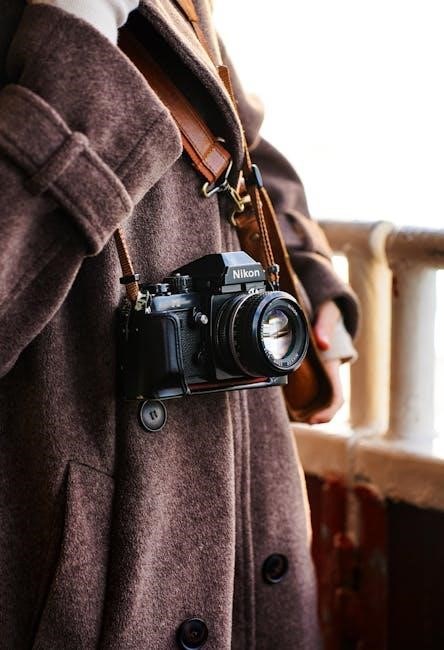Welcome to the comprehensive operating manual for the Nikon D3300! This guide will provide you with detailed instructions and information to maximize your camera’s potential. Learn about its features, settings, and capabilities to capture stunning photos and videos.
The Nikon D3300 is a versatile and user-friendly digital SLR camera designed for both beginners and experienced photographers. It boasts a high-resolution 24.2-megapixel CMOS sensor, enabling you to capture images with exceptional detail and clarity. The camera’s Nikon F mount ensures compatibility with a wide range of lenses, allowing you to explore various photographic styles and perspectives.
This operating manual will guide you through the D3300’s features, controls, and settings, helping you unlock its full potential. Whether you’re shooting landscapes, portraits, or action shots, this guide will provide the knowledge and skills to achieve stunning results. Get ready to embark on a photographic journey with your Nikon D3300!
Key Features of the Nikon D3300
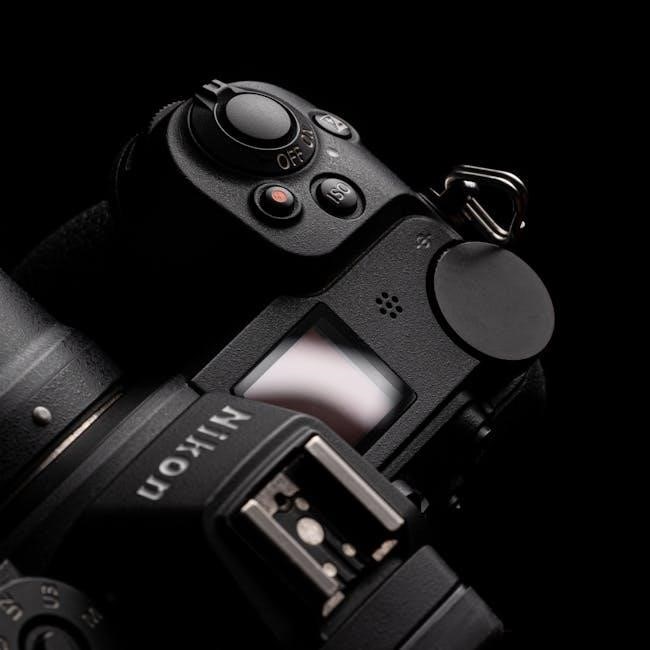
The Nikon D3300 is packed with features designed to enhance your photography experience. Its 24.2-megapixel CMOS sensor captures images with remarkable detail and clarity. The Nikon F mount provides compatibility with a vast selection of lenses, allowing for creative versatility. The camera’s intuitive interface and user-friendly controls make it easy to navigate settings and modes.
With its powerful image processor, the D3300 delivers exceptional image quality and performance. The camera also offers Full HD video recording capabilities, enabling you to capture stunning videos with ease. Its lightweight and compact design makes it ideal for travel and everyday use. Explore these key features to unlock your photographic potential.
24.2 Megapixel CMOS Sensor
The Nikon D3300 boasts a high-resolution 24.2-megapixel CMOS sensor, which is the heart of its exceptional image quality. This sensor captures a significant amount of detail, allowing for stunningly sharp and vibrant photographs. The high pixel count enables you to crop and enlarge images without sacrificing clarity. The CMOS technology ensures excellent low-light performance, reducing noise and maintaining image quality in challenging lighting conditions.
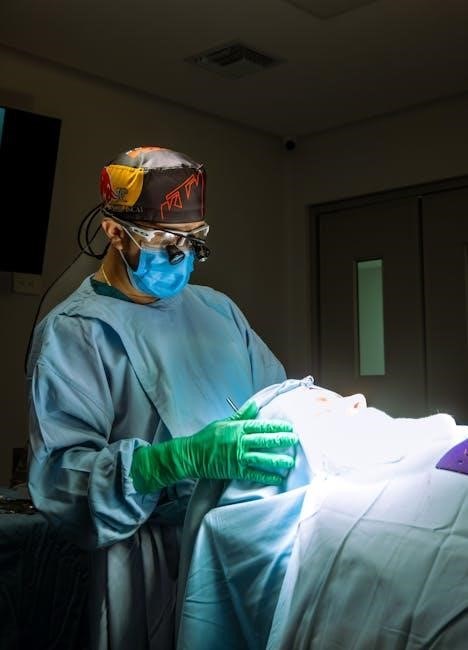
With the 24.2-megapixel sensor, you can create large prints and display your images with remarkable detail. Whether you’re shooting landscapes, portraits, or everyday moments, the D3300’s sensor delivers exceptional results. This powerful sensor is a key component in achieving professional-looking photographs.
Nikon F Mount Compatibility
The Nikon D3300 features the versatile Nikon F mount, a hallmark of Nikon’s SLR and DSLR cameras. This compatibility opens up a vast world of lens options, allowing you to choose from a wide range of NIKKOR lenses. Whether you’re looking for a wide-angle lens for landscapes, a telephoto lens for wildlife, or a prime lens for portraits, the F mount provides flexibility.
The F mount supports both autofocus and manual focus lenses, giving you control over your creative vision. Older Nikon lenses can also be used, though some features may be limited. This compatibility ensures that your investment in Nikon lenses can be used across different camera bodies. The F mount is a key feature for photographers seeking versatility.
Getting Started with Your Nikon D3300
Embarking on your photographic journey with the Nikon D3300 is an exciting endeavor. This section will guide you through the initial steps to get your camera up and running. From unpacking your new camera to taking your first photos, we’ll cover the essential setup procedures to ensure a smooth start.
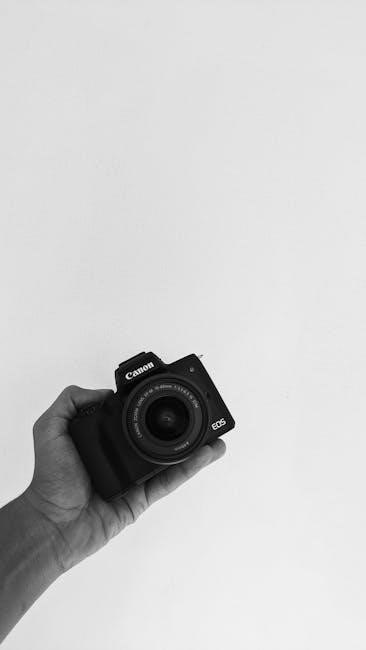
First, we’ll walk you through the initial setup process, including battery charging and basic settings adjustments. Next, you’ll learn how to properly attach a lens to your D3300, ensuring a secure and functional connection. Finally, we’ll cover the essential step of inserting an SD card, providing the necessary storage for your photos and videos. Follow these steps to prepare your camera for use.
Initial Setup and Battery Charging
Before you begin capturing stunning images with your Nikon D3300, it’s crucial to perform the initial setup and ensure your battery is fully charged. Start by carefully unpacking your camera and identifying all the included accessories. Locate the battery charger and the rechargeable battery.
Insert the battery into the charger, following the orientation indicated on both the battery and the charger. Plug the charger into a power outlet and allow the battery to charge completely. The charging indicator light will typically illuminate to show charging progress and will turn off or change color when fully charged. Once charged, you’re ready to power on your D3300.
Attaching a Lens
Attaching a lens to your Nikon D3300 is a simple process, but it’s essential to do it correctly to avoid damaging the camera or the lens. First, ensure both the camera and the lens are clean and free from dust or debris. Locate the lens mounting index on both the camera body and the lens.
Align the white dot on the lens with the corresponding white dot on the camera body. Gently insert the lens into the camera mount and rotate it clockwise until you hear a click. This click indicates that the lens is securely locked into place. To remove the lens, press the lens release button on the camera body and rotate the lens counterclockwise until it disengages.
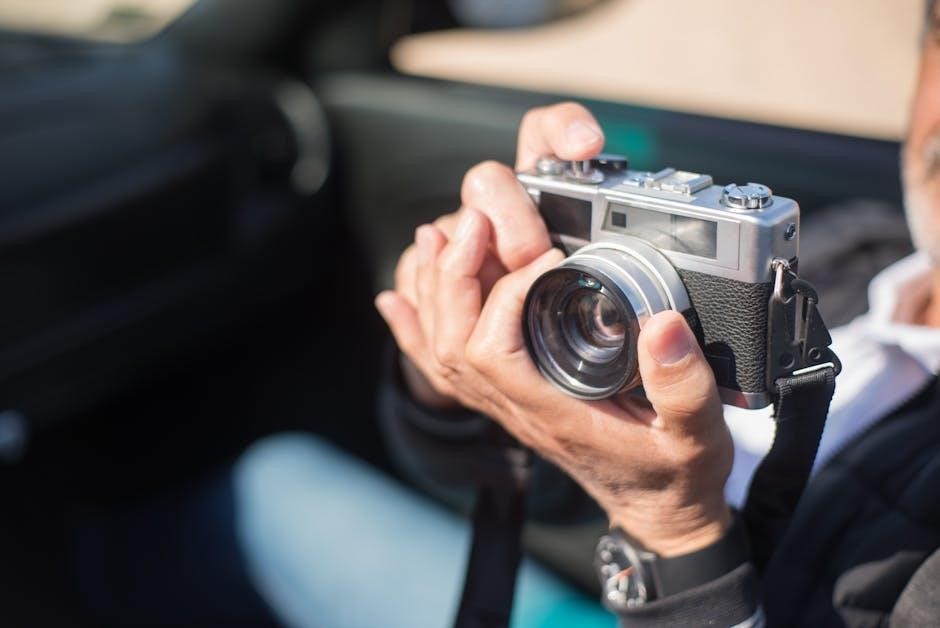
Inserting an SD Card
Inserting an SD card into your Nikon D3300 is crucial for storing your photos and videos. Locate the SD card slot on the side of the camera, usually behind a protective door. Ensure the camera is turned off before inserting or removing the SD card to prevent data corruption.
Hold the SD card with the label facing up and the metal contacts pointing towards the camera. Gently slide the SD card into the slot until it clicks into place. To remove the SD card, push it in slightly until it clicks again, then release it. The SD card will pop out, allowing you to safely remove it from the camera. Always format the SD card in the camera before using it for the first time to ensure compatibility.
Basic Operation
Understanding the basic operation of your Nikon D3300 is essential for capturing great photos. Familiarize yourself with the camera’s primary functions, including turning the camera on and off, navigating the menu system, and using the shutter button. The power switch is typically located near the shutter button, allowing for easy access.
The menu system can be accessed through the menu button on the back of the camera, providing options to adjust settings and customize your shooting experience. The shutter button is used to focus and capture images. Press it halfway to activate the autofocus system, then fully press it to take the picture. Experiment with these basic operations to become comfortable with your camera’s controls.
Understanding the Camera Modes

The Nikon D3300 offers a variety of camera modes to suit different shooting situations. These modes range from fully automatic to manual, giving you increasing control over your images. The Auto mode is the simplest, automatically adjusting settings for optimal results. Scene modes are pre-programmed settings designed for specific scenarios like portraits, landscapes, and sports.
Aperture Priority (Av) allows you to control the aperture while the camera selects the shutter speed. Shutter Priority (Tv) lets you set the shutter speed, and the camera adjusts the aperture. Manual (M) mode provides complete control over both aperture and shutter speed, offering the most creative flexibility. Experiment with each mode to learn how they affect your photos.
Using the Viewfinder
The viewfinder on the Nikon D3300 allows you to compose your shots directly through the lens. This provides a more immersive shooting experience and helps you see the scene as the camera sees it. To use the viewfinder, simply bring the camera up to your eye and look through the rubber eyepiece. Adjust the diopter dial, located near the viewfinder, until the image appears sharp and clear.
Within the viewfinder, you’ll see various indicators, including focus points, metering information, and exposure settings. These indicators provide valuable feedback about your camera’s settings and help you achieve the desired results. Using the viewfinder can improve stability and reduce glare in bright conditions, leading to better photographs.
Image Playback and Review
After capturing your photos with the Nikon D3300, reviewing them is essential for immediate feedback and adjustments. To enter playback mode, press the playback button, typically indicated by a triangle symbol. This displays your most recently captured image on the LCD screen.
Use the multi-selector to navigate through your images, viewing them individually. You can zoom in to check focus and detail by pressing the zoom-in button and zoom out using the zoom-out button. Pressing the information button displays shooting data, such as aperture, shutter speed, and ISO. The delete button allows you to erase unwanted images quickly. Regularly reviewing your images helps you refine your technique and improve your photography skills.
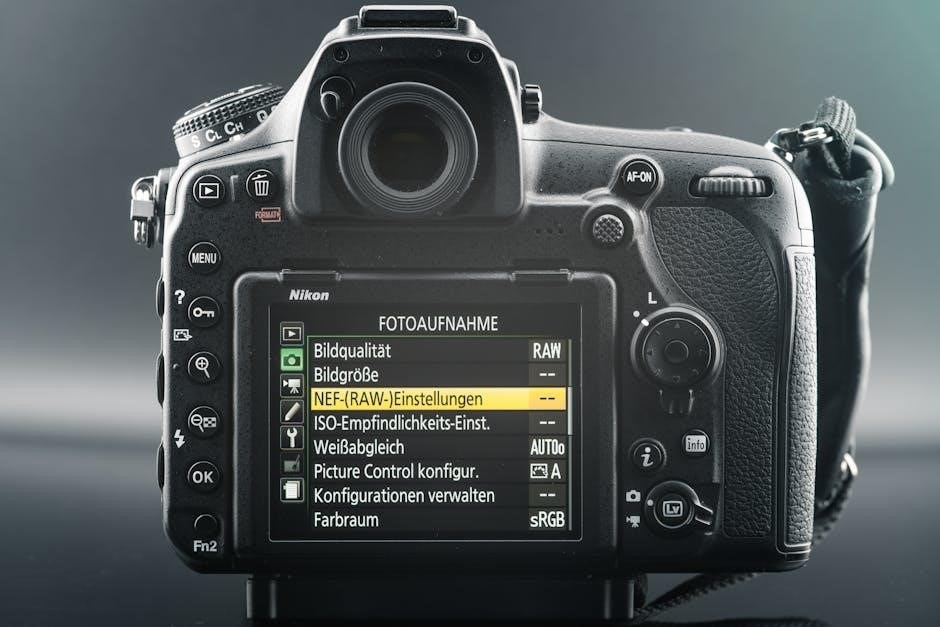
Advanced Guide
The Nikon D3300 offers a range of advanced features for photographers looking to move beyond basic operation. This section delves into manual settings, allowing you to take full control of your camera’s capabilities. Explore aperture priority mode (A), which lets you control depth of field, and shutter priority mode (S), which allows you to manage motion blur.
Manual mode (M) grants complete control over both aperture and shutter speed, offering ultimate creative freedom. We will also cover white balance settings for accurate color reproduction and ISO sensitivity for optimal image brightness in various lighting conditions. Mastering these advanced techniques unlocks the full potential of your Nikon D3300.
Manual Settings Adjustment
Taking control of your Nikon D3300’s manual settings opens a world of creative possibilities. Start by understanding the exposure triangle: aperture, shutter speed, and ISO. Aperture controls the lens opening, influencing depth of field. A wider aperture (lower f-number) creates a shallow depth of field, blurring the background, while a smaller aperture (higher f-number) increases sharpness throughout the image.
Shutter speed determines how long the camera’s sensor is exposed to light, affecting motion blur. Faster shutter speeds freeze action, while slower speeds blur movement. ISO controls the sensor’s sensitivity to light. Lower ISOs produce cleaner images, while higher ISOs are useful in low light but can introduce noise.
Live View Mode
Live View mode on the Nikon D3300 allows you to compose your shots using the camera’s LCD screen instead of the viewfinder. To activate Live View, simply press the LV button located on the top right of the camera’s back panel. The mirror will flip up, and the scene will be displayed on the screen.
This mode is particularly useful for shooting at unusual angles, macro photography, or when using a tripod. While in Live View, you can also access various settings and information, such as focus mode, exposure compensation, and white balance. Note that prolonged use of Live View can drain the battery faster and may cause the camera to heat up.
Focus Mode Settings
The Nikon D3300 offers several focus mode settings to suit various shooting situations. To access these settings, navigate to the shooting menu or use the quick settings accessible through the information display. The primary focus modes include AF-S (Single-servo AF), AF-C (Continuous-servo AF), and MF (Manual Focus).
AF-S is ideal for stationary subjects, locking focus once achieved. AF-C is best for moving subjects, continuously adjusting focus as the subject moves. MF allows you to manually adjust the focus using the lens’s focusing ring, providing precise control. Understanding these modes is crucial for capturing sharp, well-focused images in different scenarios. Experiment with each mode to determine which works best for your subject.
Menu Functions
The Nikon D3300’s menu system is your central hub for customizing camera settings and accessing various functions. Navigating the menu is straightforward using the camera’s multi-selector. The menu is divided into several sections, including playback, shooting, setup, retouch, and recent settings, each containing specific options to tailor your shooting experience.
The playback menu allows you to review and manage your images and videos. The shooting menu controls image quality, ISO settings, white balance, and other essential parameters for capturing the perfect shot. The setup menu enables you to adjust general camera settings like date, time, language, and screen brightness. Understanding these menu functions is vital for optimizing your D3300’s performance.
Shooting Menu Options
Within the shooting menu of your Nikon D3300, you’ll discover a wealth of options to fine-tune your image capture settings. Image quality settings let you choose the file format (JPEG, RAW, or both) and the resolution of your photos. ISO sensitivity adjustments allow you to control the camera’s sensitivity to light, crucial for shooting in various lighting conditions.
White balance settings ensure accurate color reproduction by compensating for different light sources. Picture control allows you to select predefined styles like vivid, neutral, or monochrome, or create custom styles. Other options include setting the release mode (single, continuous, self-timer), managing active D-lighting for balanced exposure, and configuring auto bracketing for exposure, white balance, or active D-lighting. Mastering these settings unlocks creative possibilities.
Custom Settings
The custom settings menu on the Nikon D3300 offers a range of options to personalize the camera’s behavior to match your shooting style. You can adjust auto-focus settings, such as focus tracking with lock-on, to better capture moving subjects. Exposure settings can be fine-tuned, allowing you to modify the exposure compensation steps or the metering mode for specific situations.
Timers and AE lock settings enable customization of the self-timer duration and the behavior of the auto-exposure lock button. Other settings include assigning different functions to buttons, customizing display options, and adjusting the information displayed in the viewfinder. By tailoring these settings, you can optimize the camera for your unique needs.
Troubleshooting
Encountering issues with your Nikon D3300? This section provides guidance on resolving common problems. If your camera is not turning on, ensure the battery is properly charged and inserted correctly. Image quality issues may arise from incorrect settings or dirty lenses, so check your settings and clean the lens with appropriate materials.
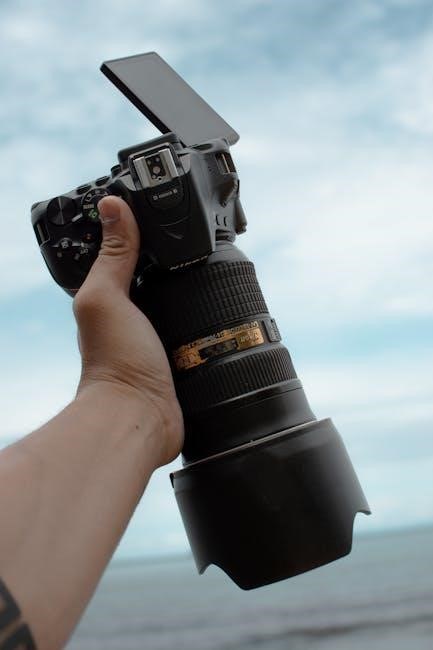
If the camera is not focusing, verify the focus mode and ensure the lens is compatible. Error messages on the LCD screen often indicate specific problems; consult the manual for their meanings and recommended solutions. For more complex issues, consider consulting Nikon’s support resources or a professional camera technician.
Common Issues and Solutions
One frequent problem is blurry images. Ensure your shutter speed is fast enough to prevent motion blur, especially in low light. Another common issue is underexposed or overexposed photos. Adjust the aperture, shutter speed, or ISO settings to achieve proper exposure. If the camera fails to recognize the SD card, try reformatting the card or using a different one.
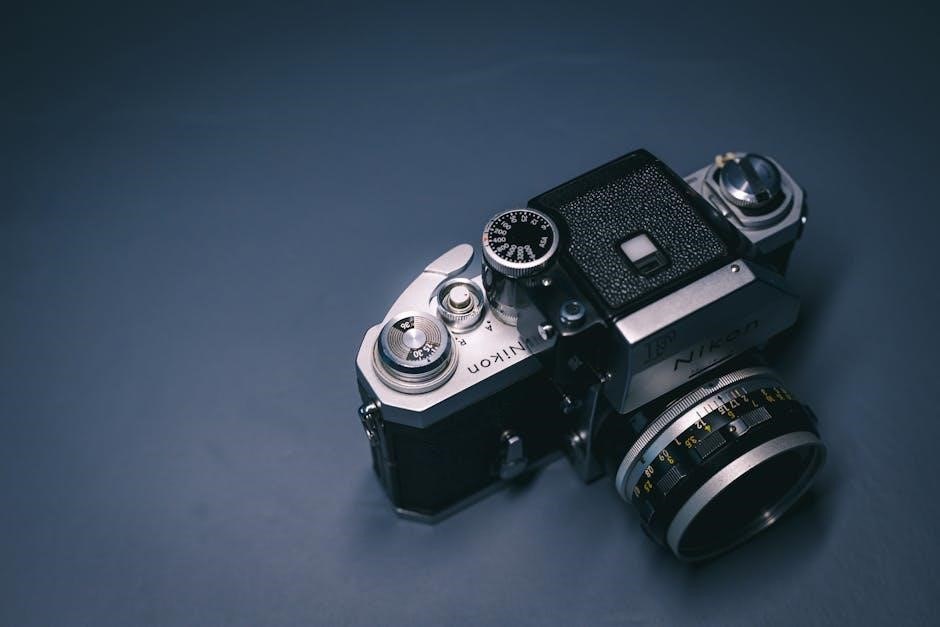
If the autofocus system is struggling, switch to manual focus to fine-tune the image. When the LCD screen displays an error message, consult the manual for specific troubleshooting steps. Always keep the lens clean to avoid image imperfections. These simple steps can resolve most common issues.
Specifications
The Nikon D3300 boasts a 24.2-megapixel DX-format CMOS sensor, delivering exceptional image quality. It features an EXPEED 4 image processor for fast performance and low noise. The camera supports Nikon F mount lenses and offers a wide ISO range for various lighting conditions. It can record Full HD 1080p videos at up to 60 fps.
The D3300 has an 11-point autofocus system for precise focusing. The camera also includes a 3-inch LCD monitor for reviewing images and videos. The approximate dimensions are 124 x 98 x 75.5 mm, making it compact and easy to handle; It uses an EN-EL14a rechargeable Li-ion battery.
Technical Specifications Overview
The Nikon D3300 features a 24.2 MP DX-format CMOS sensor without an optical low-pass filter, enhancing image sharpness. Its ISO sensitivity ranges from 100 to 12800, expandable to 25600. The camera uses Nikon’s F lens mount and is compatible with AF-S and AF-I lenses. It records Full HD 1080p video at 60/50/30/25/24 fps and offers continuous shooting at up to 5 fps.
The D3300 has an 11-point autofocus system and a 3.0-inch LCD monitor with 921k-dot resolution. It uses SD/SDHC/SDXC memory cards and is powered by an EN-EL14a battery, providing approximately 700 shots per charge. Its dimensions are 124 x 98 x 75.5 mm, and it weighs around 460g with battery and SD card.
Nikon Manual Viewer 2 App
The Nikon Manual Viewer 2 App is a convenient tool for accessing Nikon digital camera manuals on your smartphone or tablet. Available for both iOS and Android devices, this app allows you to download and view manuals offline, ensuring you have access to essential information anytime, anywhere. It supports a wide range of Nikon cameras, including the D3300, providing detailed instructions and troubleshooting tips.
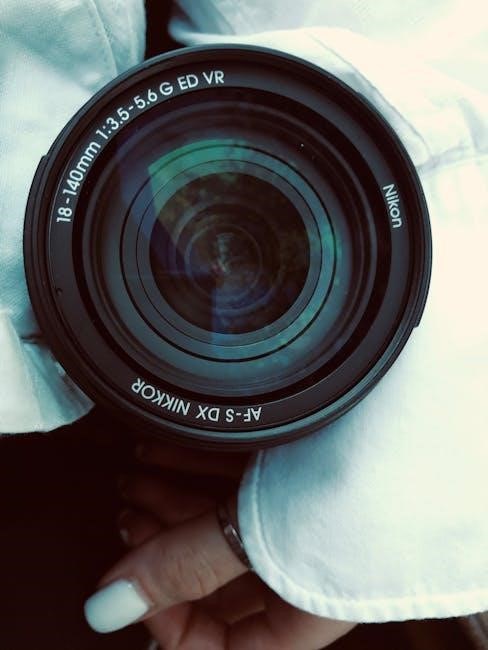
To use the app, simply download it from the App Store or Google Play. Once installed, you can search for and download the D3300 manual for offline viewing. This ensures quick access to important information about your camera’s features, settings, and operation, right at your fingertips;
Downloading and Using the App
To begin using the Nikon Manual Viewer 2 App, first, download it from either the App Store (for iOS devices) or Google Play Store (for Android devices). Search for “Nikon Manual Viewer 2” and install the application on your device. Once the installation is complete, open the app.
Within the app, you can browse for the Nikon D3300 manual. After locating it, download the manual to your device for offline access. The app provides a user-friendly interface for navigating through the manual, allowing you to quickly find information on camera features, settings adjustments, and troubleshooting tips. This ensures you always have the D3300 manual at your convenience.
